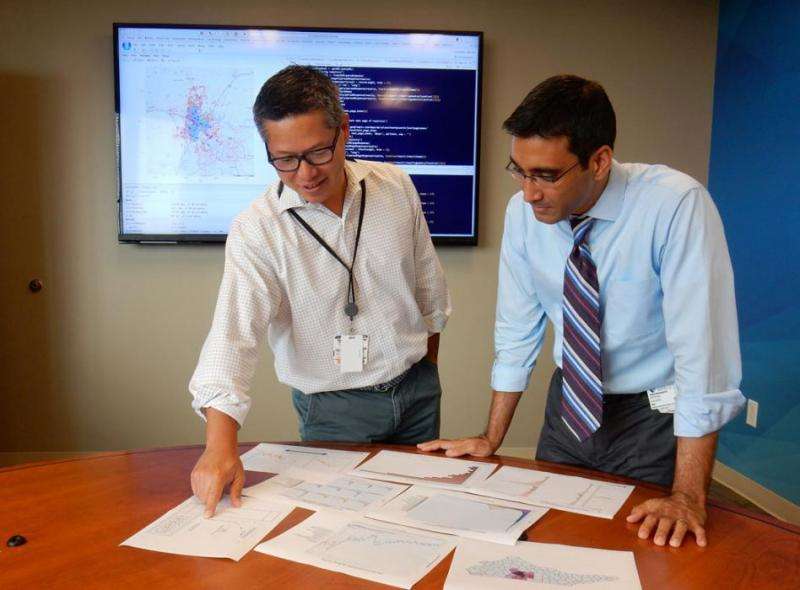Teaching computers to create an early warning system for kidney disease

About twice every hour, all of the blood in our bodies filters through our kidneys, removing waste and excess water to produce urine. But this important kidney function is irreversibly compromised in about 20 million Americans by chronic disease, most often related to poorly controlled diabetes and high blood pressure. In many cases, modern medicine does nothing to slow kidney disease for one very simple reason—most who are affected don't know it until it's already too late.
"Kidney disease often progresses silently to late stages," says Uptal Patel, a Duke nephrologist and kidney transplant specialist. "People don't feel any symptoms until they've either reached or nearly reached complete kidney failure."
A Duke team, including Patel, Erich Huang in the Department of Biostatistics and Bioinformatics and Katherine Heller in the Department of Statistical Science and their colleagues, is working to devise an early warning system to catch chronic kidney disease much earlier. Even better, they plan to do so by crunching the data that is often readily available to doctors in patients' electronic medical records.
Data Mining
"It's about awareness," Huang said. "Primary care physicians are very busy. A lot of data is collected 'under the hood' in electronic health records, but we don't use the data as effectively as we could."
Since many people who have undiagnosed kidney disease undergo routine blood and urine testing to monitor other health conditions, the signs of kidney trouble are often right there in their records, if only there were a system sophisticated enough to notice and sound the alarm.
With funding from the Duke CTSA through the Duke Translational Research Institute (DTRI) Collaborative Pilot Award, the interdisciplinary team is applying statistical methods that would allow them to capture data collected in health records over time. The goal is to use the data to identify declining kidney function and to teach the computers to better predict kidney function problems out into the future.
Most current methods to identify patients at risk for chronic kidney disease offer only a static snapshot of an individual's kidney function status. The Duke team has a loftier goal. They want to make use of all existing data on a patient to predict his or her future kidney disease trajectory. With better information about the probable decline in kidney function, providers will be better equipped to provide more timely care according to guideline-based recommendations, improve patient engagement, and shared-decision making about various treatment options.
When patients learn about their kidney disease early, they can slow the progression by better controlling their blood sugar and blood pressure and other healthy lifestyle changes. This gives them more time to work with their healthcare team to prepare for future health challenges, such as dialysis and consideration of kidney transplantation, the preferred treatment for kidney failure.
"Our data-rich approach uses all prior data that might allow us to better predict future risk," Patel said. "The goal is to help physicians have more engaging conversations with their patients."
That could be an important advance not only for patients affected by this condition, but also for health systems. Because kidney disease progresses silently, patients frequently learn of their condition in the emergency room. There, they find themselves receiving an unplanned 'crash start' to dialysis, a life-sustaining blood-cleansing procedure designed to fill in for what their kidneys can no longer do. In 2011, more than 40 percent of people who first received such treatments had never seen a kidney specialist for treatment before.
Understanding the Big Picture
The Duke team already has an early version of their predictive model up and running and is working on a second iteration. The next, and likely bigger, challenge is to work out the best way to capture and usefully convey this information to primary care doctors in the clinic using a real-time, web-based application. They hope to link interactive visualizations and reports that convey meaningful insights about the risk of progression of the disease with guideline-based recommendations, where appropriate.
Once developed, they will begin to roll out their new tools to physicians. The initial pilot will work with Duke Connected Care (dukeconnectedcare.org (link is external)), a community-based, physician-led network that aims to simultaneously improve the quality of health care and address rising health care costs. Improvements in the diagnosis and management of chronic kidney disease would be expected to produce a considerable cost savings. The current price tag associated with end-stage kidney failure is almost $50 billion per year.
While the CTSA-funded team is focusing their attention on kidney disease for now, this challenge of making the most out of medical data found in health records and health systems is valid for many health conditions. Huang points to recent studies showing that, even with routine collection of surgical outcomes data as part of the American College of Surgeons National Surgical Quality Improvement Program (link is external), hospitals often don't show the anticipated improvements in quality over time.
"It's an illustration that, although you may be collecting the data, that doesn't mean you are utilizing it very well," Huang said.
As more and more health-related data pours into electronic health records, it's clear that healthcare systems are scrambling to keep up.
"The challenge for health care information technology is: how do you acquire the agility that a startup has?" Huang said. "Facebook releases new features weekly and very rarely if ever crashes because they are using the most modern frameworks for developing their platform. Of course we need a layer of governance to ensure patient safety, but we want to push this boundary and move faster so that the rate-limiting step [in medicine] isn't technical."


















